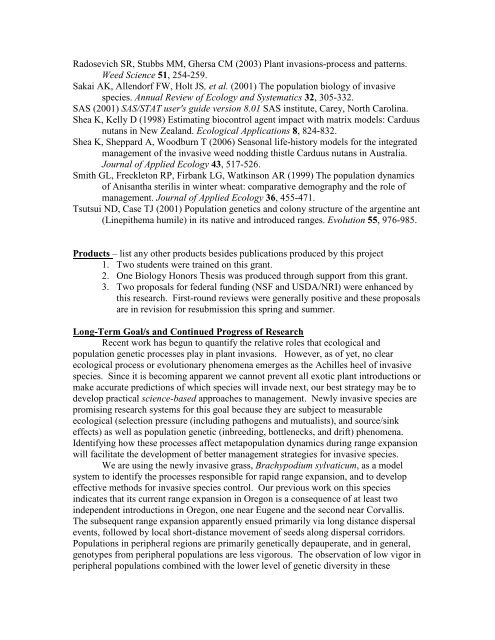Final Report - Center for Invasive Plant Management
Final Report - Center for Invasive Plant Management
Final Report - Center for Invasive Plant Management
- No tags were found...
You also want an ePaper? Increase the reach of your titles
YUMPU automatically turns print PDFs into web optimized ePapers that Google loves.
Radosevich SR, Stubbs MM, Ghersa CM (2003) <strong>Plant</strong> invasions-process and patterns.Weed Science 51, 254-259.Sakai AK, Allendorf FW, Holt JS, et al. (2001) The population biology of invasivespecies. Annual Review of Ecology and Systematics 32, 305-332.SAS (2001) SAS/STAT user's guide version 8.01 SAS institute, Carey, North Carolina.Shea K, Kelly D (1998) Estimating biocontrol agent impact with matrix models: Carduusnutans in New Zealand. Ecological Applications 8, 824-832.Shea K, Sheppard A, Woodburn T (2006) Seasonal life-history models <strong>for</strong> the integratedmanagement of the invasive weed nodding thistle Carduus nutans in Australia.Journal of Applied Ecology 43, 517-526.Smith GL, Freckleton RP, Firbank LG, Watkinson AR (1999) The population dynamicsof Anisantha sterilis in winter wheat: comparative demography and the role ofmanagement. Journal of Applied Ecology 36, 455-471.Tsutsui ND, Case TJ (2001) Population genetics and colony structure of the argentine ant(Linepithema humile) in its native and introduced ranges. Evolution 55, 976-985.Products – list any other products besides publications produced by this project1. Two students were trained on this grant.2. One Biology Honors Thesis was produced through support from this grant.3. Two proposals <strong>for</strong> federal funding (NSF and USDA/NRI) were enhanced bythis research. First-round reviews were generally positive and these proposalsare in revision <strong>for</strong> resubmission this spring and summer.Long-Term Goal/s and Continued Progress of ResearchRecent work has begun to quantify the relative roles that ecological andpopulation genetic processes play in plant invasions. However, as of yet, no clearecological process or evolutionary phenomena emerges as the Achilles heel of invasivespecies. Since it is becoming apparent we cannot prevent all exotic plant introductions ormake accurate predictions of which species will invade next, our best strategy may be todevelop practical science-based approaches to management. Newly invasive species arepromising research systems <strong>for</strong> this goal because they are subject to measurableecological (selection pressure (including pathogens and mutualists), and source/sinkeffects) as well as population genetic (inbreeding, bottlenecks, and drift) phenomena.Identifying how these processes affect metapopulation dynamics during range expansionwill facilitate the development of better management strategies <strong>for</strong> invasive species.We are using the newly invasive grass, Brachypodium sylvaticum, as a modelsystem to identify the processes responsible <strong>for</strong> rapid range expansion, and to developeffective methods <strong>for</strong> invasive species control. Our previous work on this speciesindicates that its current range expansion in Oregon is a consequence of at least twoindependent introductions in Oregon, one near Eugene and the second near Corvallis.The subsequent range expansion apparently ensued primarily via long distance dispersalevents, followed by local short-distance movement of seeds along dispersal corridors.Populations in peripheral regions are primarily genetically depauperate, and in general,genotypes from peripheral populations are less vigorous. The observation of low vigor inperipheral populations combined with the lower level of genetic diversity in these
















